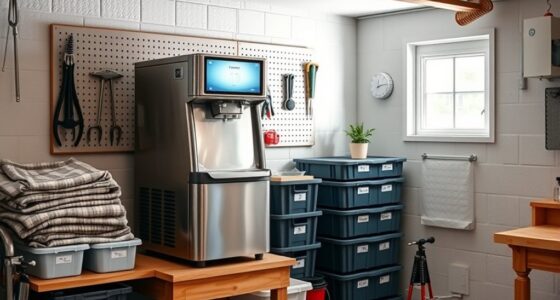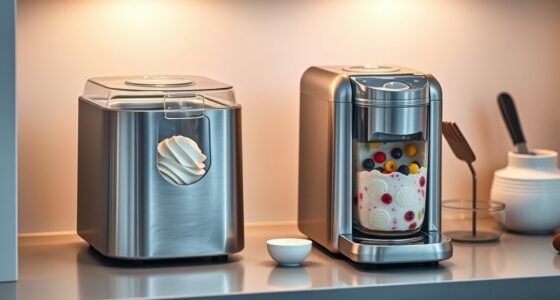Choosing between air-cooled and water-cooled machines depends on your performance needs, environment, and maintenance capacity. Air cooling is simpler, quieter, and suitable for limited spaces or cooler climates, while water cooling offers superior thermal regulation for high-performance applications but requires more upkeep and space. If you want better cooling with longer lifespan, water may be right. To discover which option fits your situation best, consider the key differences discussed below.
Key Takeaways
- Water cooling offers superior thermal regulation, ideal for high-performance systems with demanding heat loads.
- Air cooling is simpler, more affordable, and requires less maintenance, suitable for space-constrained or budget-conscious setups.
- Water cooling is quieter but involves higher initial costs and ongoing maintenance for leak checks and coolant replacement.
- Air cooling is environmentally friendly, using less water and energy, and performs well in cooler climates or water-scarce areas.
- Choose water cooling for longevity and maximum cooling efficiency; opt for air cooling for ease of use and lower operational costs.
How Air Cooling Works and Its Key Benefits
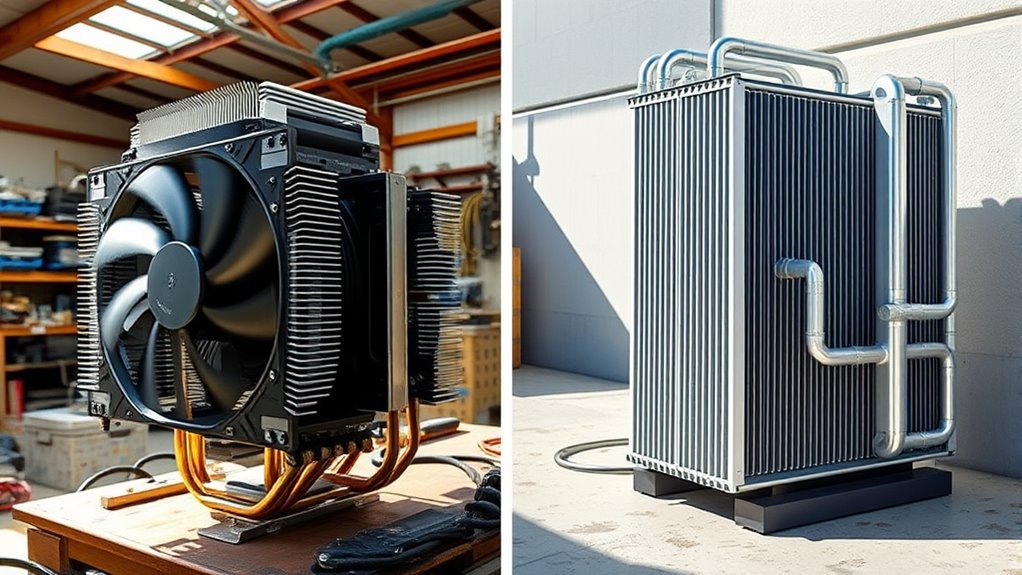
Air cooling works by using fans or vents to circulate air over a machine’s components, dissipating heat naturally. This method enhances thermal efficiency by maintaining a steady temperature, preventing overheating that can reduce performance. One of its key benefits is noise reduction; air cooling tends to be quieter than other systems because it relies on simple fans rather than complex pumps or water circulation. You’ll notice less mechanical noise, making it ideal for quieter environments or workspaces where noise matters. Additionally, air cooling systems are generally easier to install and maintain, which saves you time and effort. Proper thermal management is crucial for optimizing machine performance and longevity. Moreover, advances in cooling technology continue to improve the effectiveness of air cooling systems, making them more reliable and efficient for various applications. For instance, ventilation design improvements have helped increase airflow efficiency, further enhancing cooling performance. As a result, the integration of innovative fan systems has contributed to the increasing popularity of air cooling solutions, especially in compact or lightweight devices. Overall, air cooling provides a straightforward, effective way to manage heat while keeping noise levels low and ensuring your machine’s maximum performance.
The Mechanics and Advantages of Water Cooling

Water cooling works by circulating a liquid coolant through a series of tubes and blocks attached directly to critical components, like the CPU or GPU. This setup enhances thermal regulation by efficiently transferring heat away from high-performance parts. Fluid dynamics plays a key role in optimizing coolant flow, ensuring maximum heat absorption and dissipation. Unlike air cooling, water cooling can handle higher heat loads more effectively, maintaining stable temperatures even under demanding workloads. The liquid absorbs heat as it moves through the system, then passes through a radiator where air cools it down before recirculating. This continuous cycle keeps your components cooler, reducing thermal stress and improving overall performance. Water cooling’s precise thermal regulation makes it a preferred choice for overclockers and enthusiasts seeking quieter, more efficient cooling solutions. Additionally, proper system maintenance ensures the cooling performance remains optimal over time. Using high-quality components and regular coolant replacement can further enhance longevity and efficiency. Proper installation practices are also crucial to prevent leaks and ensure optimal operation, especially considering the complexities involved in fluid flow management to prevent air bubbles and blockages. Moreover, understanding the thermal transfer mechanisms involved can help optimize system design for better cooling efficiency.
Comparing Cost, Maintenance, and Longevity
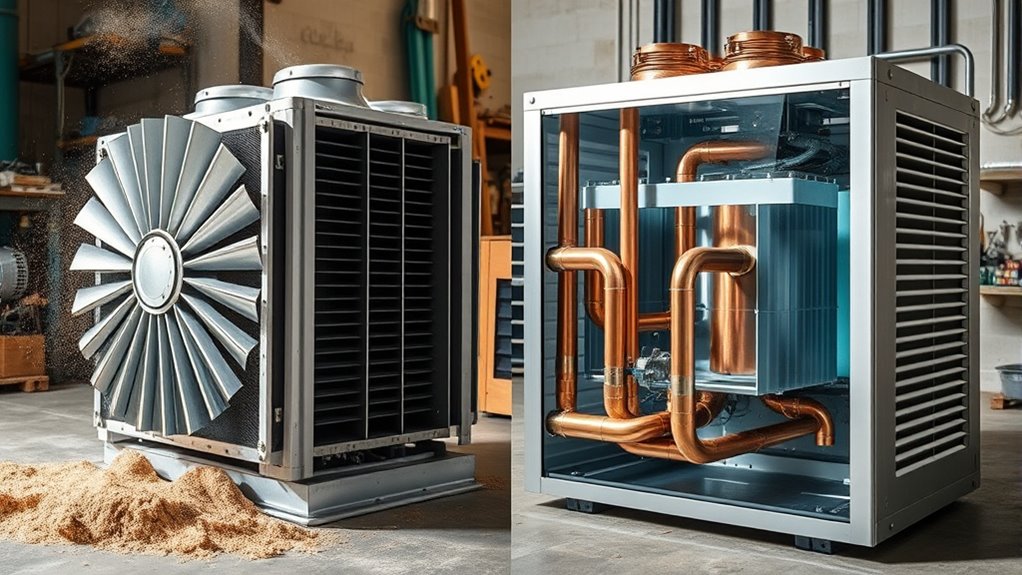
While water-cooled systems often have higher upfront costs, they can be more cost-effective over time thanks to better cooling performance and increased longevity. Water cooling typically reduces noise levels, making your environment quieter, which is a big advantage if noise matters to you. Additionally, thermal management is a crucial factor in choosing between the two, as water cooling generally provides superior temperature regulation for demanding tasks. Proper system design is essential to maximize efficiency and reliability in water-cooled setups. However, installation complexity can be a downside, as setting up water systems requires more planning and expertise compared to air-cooled units. Maintenance for water-cooled machines tends to be more involved, involving regular checks for leaks and coolant quality. Despite this, their durability often means fewer replacements over the years, saving you money long-term. Furthermore, high-pressure operation allows water-cooled systems to handle demanding tasks more effectively. An additional consideration is that regulatory standards for water cooling systems are often stricter, emphasizing safety and quality. Understanding coolant compatibility helps prevent potential damage and ensures optimal system performance. Overall, if you’re willing to handle the initial setup and maintenance, water cooling offers a reliable, long-lasting solution that can outperform air cooling in both cost-effectiveness and noise reduction.
Environmental Impact and Suitability for Different Settings
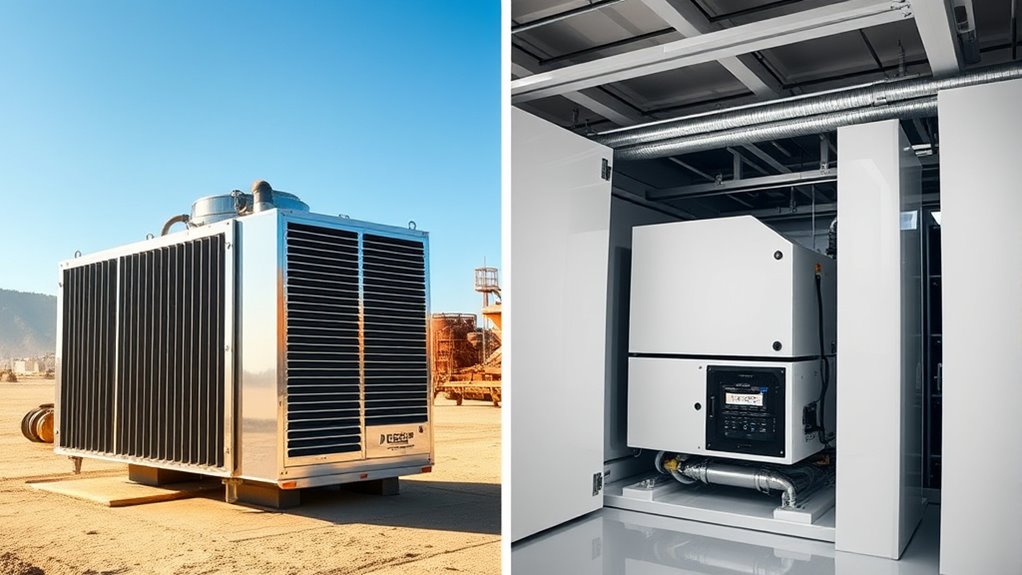
Choosing the right cooling system depends heavily on your environmental priorities and the setting where it will be used. Air-cooled systems often have a lower environmental impact because they require less water and can use renewable options like outdoor air, making them suitable for areas with water scarcity. They also tend to be more energy-efficient in cooler climates, reducing overall energy consumption. Water-cooled machines, while more efficient in some high-performance environments, use significant water resources and may pose risks of contamination or leaks. If sustainability and reducing water use are top priorities, air-cooled systems are generally better suited. Additionally, water consumption is a critical factor to consider when evaluating the environmental impact of cooling systems. Consider your local climate and resource availability to determine which system aligns best with your environmental goals and the specific demands of your setting. Understanding the environmental impact of each system can help guide your decision-making process to choose the most sustainable option. Furthermore, energy efficiency plays a vital role in minimizing the carbon footprint associated with cooling systems, making it an important consideration in your choice. Incorporating sustainable cooling technologies can further enhance your commitment to eco-friendly practices, especially as advancements in green energy solutions continue to evolve.
Making the Right Choice: Factors to Consider

Selecting the right cooling system involves weighing several key factors to guarantee it meets your specific needs. Noise levels are vital if you work in noise-sensitive environments, as water-cooled machines tend to be quieter. Installation complexity also matters; air-cooled systems are usually easier and faster to set up, while water-cooled systems may require more plumbing and maintenance. Consider your space, budget, and technical expertise. Use the table below to compare:
| Factor | Water-Cooled | Air-Cooled |
|---|---|---|
| Noise Levels | Quieter | Louder |
| Installation Complexity | More complex, needs plumbing | Simpler, no plumbing |
| Maintenance | Regular, more detailed | Less maintenance |
| Space Requirements | Compact, needs water source | Larger, better airflow |
Choosing between these options also depends on cooling efficiency, which can influence your operational costs and overall system performance. Additionally, understanding system longevity can help ensure your investment remains cost-effective over time. Regular inspections and proper maintenance practices are essential for prolonging system lifespan and optimizing performance.
Frequently Asked Questions
Which Cooling Method Is Better for Overclocked Gaming PCS?
For overclocked gaming PCs, liquid cooling often offers superior thermal performance, keeping your components cooler under heavy loads. It’s more efficient at dissipating heat, which helps prevent overheating and maintains stable performance. While air cooling can work, liquid cooling generally provides quieter operation and better cooling margins, making it the perfect choice if you want maximum overclocking potential and longevity for your gaming setup.
How Does Noise Level Differ Between Air and Water Cooling Systems?
You might be surprised by the noise comparison between cooling systems. Water cooling often runs quieter because its fans operate at lower speeds, reducing sound levels. Air cooling, however, can get louder under heavy loads as fans spin faster to dissipate heat. If silent operation matters, water cooling could be your best bet. But if you don’t mind some noise, air cooling remains a reliable, budget-friendly choice.
Can Water Cooling Systems Be Integrated Into Existing Air-Cooled Setups?
You can definitely retrofit water cooling systems into your existing air-cooled setup. Many kits are designed for easy system integration, guaranteeing compatibility with your current components. Before proceeding, check the retrofit compatibility of your hardware and plan for any needed modifications. Proper installation ensures efficient cooling and minimizes disruption, allowing you to enjoy the benefits of water cooling without replacing your entire setup.
Are There Any Health or Safety Concerns With Water Cooling Components?
Water cooling systems, while impressive, can pose serious safety concerns if not managed properly. The coolant toxicity means leaks could expose you to harmful chemicals, and leak risks might cause electrical damage or accidents. You need to handle these components carefully, regularly inspect for leaks, and guarantee proper ventilation. Ignoring these safety measures is like inviting chaos—prioritize maintenance and safety protocols to keep your setup secure and efficient.
What Are the Future Technological Advancements in Cooling Systems?
You’ll see future cooling systems become smarter and more eco-friendly, integrating advanced sensors and AI for ideal performance. Expect innovations like adaptive cooling that adjusts based on demand, reducing energy use. Eco-friendly systems will utilize biodegradable coolants and more efficient heat exchange methods. These advancements will make cooling systems more reliable, sustainable, and easier to manage, helping you save energy while maintaining peak performance in your equipment.
Conclusion
Choosing between air and water cooling is like selecting a boat for your journey—air cooling is your sturdy sailboat, simple and reliable for calm waters, while water cooling is a sleek yacht, offering speed and efficiency for rougher seas. Consider your destination, budget, and needs. Just like steering through the open waters, your decision depends on balancing performance, maintenance, and environment. Pick what suits your voyage best, and enjoy smooth sailing ahead.



